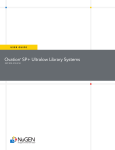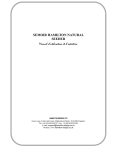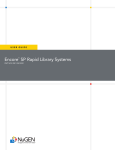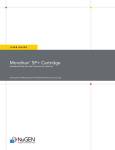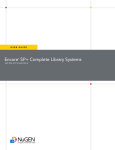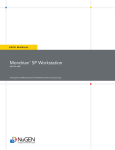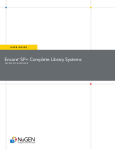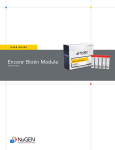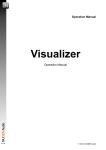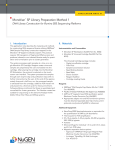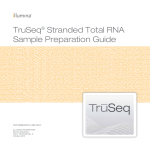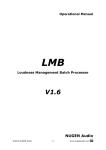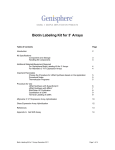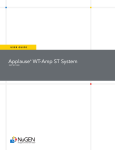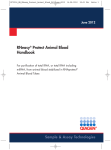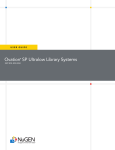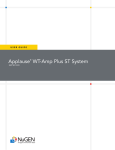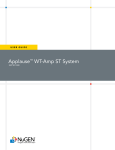Download Ovation® SP+ RNA-Seq Library Systems
Transcript
USER GUIDE Ovation SP+ RNA-Seq Library Systems ® PART NOs. 8161, 8162 Patents, Licensing and Trademarks ©2013 NuGEN Technologies, Inc. All rights reserved. The Encore®, Ovation® and Applause® families of products and methods of their use are covered by several issued U.S. and International patents and pending applications (www.nugeninc.com). NuGEN, Ovation, SPIA, Ribo-SPIA, Applause, Encore, Prelude, Mondrian and Imagine More From Less are trademarks or registered trademarks of NuGEN Technologies, Inc. Other marks appearing in these materials are marks of their respective owners. Specific information on patents, trademarks and licenses related to the Mondrian™ SP Universal Cartridge, the Mondrian™ SP+ Cartridge, the Mondrian™ SP Workstation and the Mondrian™ SP+ Workstation may be found in the Mondrian SP Universal Cartridge User Guide (M01265), the Mondrian SP Workstation User Manual (M01264) and the Mondrian SP+ Workstation User Manual (M01322). The purchase of this product conveys to the buyer the limited, non-exclusive, non-transferable right (without the right to modify, reverse engineer, resell, repackage or further sublicense) under these patent applications and any patents issuing from these patent applications to use this product and methods, accompanying this user guide, for research and development purposes solely in accordance with the intended use described and the written instructions provided in this user guide. No license to make or sell products by use of this product is granted to the buyer whether expressly, by implication, by estoppels or otherwise. In particular, the purchase of this product does not include or carry any right or license to use, develop or otherwise exploit this product commercially and no rights are conveyed to the buyer to use the product or components of the product for purposes including commercial services or clinical diagnostics. For information on purchasing a license to the NuGEN patents for uses other than in conjunction with this product or to use this product for purposes other than research, please contact NuGEN Technologies, Inc., 201 Industrial Road, Suite 310, San Carlos, CA 94070. Phone 888-654-6544 or 650-590-3600; FAX 888-296-6544 or 650-590-3630. Warranty NuGEN warrants that this product meets the performance standards described in the Company’s product and technical literature for a period of six months from the date of purchase, provided that the product is handled and stored according to published instructions, and that the product is not altered or misused. If the product fails to meet these performance standards, NuGEN will replace the product free of charge or issue a credit for the purchase price. NuGEN’s liability under this warranty shall not exceed the purchase price of the product. NuGEN shall assume no liability for direct, indirect, consequential or incidental damages arising from the use, results of use or inability to use its products. NuGEN reserves the right to change, alter or modify any product to enhance its performance and design. NuGEN’s products are developed, designed and sold FOR RESEARCH USE ONLY. This product is not to be used for diagnostic or therapeutic purposes, nor is it to be administered to humans or animals. Except as expressly set forth herein, no right to modify, reverse engineer, distribute, offer to sell or sell NuGEN’s product is conveyed or implied by buyer’s purchase of this NuGEN product. The buyer agrees to use NuGEN products accompanying the product insert in accordance with the intended use and the written instructions provided. Table of Contents Contents I.Introduction.......................................................................................................... 1 A.Background........................................................................................................ 1 B. Performance Specifications................................................................................ 3 C. Quality Control .................................................................................................. 3 D. Storage and Stability.......................................................................................... 3 E. Material Safety Data Sheet (MSDS).................................................................... 4 II.Components......................................................................................................... 5 A. Reagents Provided............................................................................................. 5 B. Additional Equipment, Reagents and Labware................................................. 8 III. Planning the Experiment...................................................................................... 9 A. Input RNA Requirements................................................................................... 9 B. Using RNase-free Techniques.......................................................................... 10 C. RNA Storage.................................................................................................... 11 D. Using Ovation SP+ RNA-Seq Library Systems on Illumina NGS Systems........ 11 E. Library Storage................................................................................................. 11 IV.Protocol.............................................................................................................. 12 A.Overview.......................................................................................................... 12 B. Protocol Notes................................................................................................. 12 C. Cartridge Quality Control Check..................................................................... 12 D. Programming the Thermal Cycler.................................................................... 14 E. Protocol for the Ovation SP+ RNA-Seq Library Systems: First and Second Strand cDNA Synthesis.................................................................................... 15 F. Protocol for the Ovation SP+ RNA-Seq Library Systems: SPIA Amplification and Library Preparation on SP+ Cartridge....................................................... 17 V. Quantitative and Qualitative Assessment of the Purified Libraries...................... 25 A.Overview.......................................................................................................... 25 B. Quantification Using KAPA Biosystems Products............................................. 25 C. Gel Analysis of KAPA qPCR Product................................................................ 25 VI. Technical Support................................................................................................ 27 VII. Appendix............................................................................................................ 28 A. Preparation of Ovation SP+ RNA-Seq Library Systems Libraries for Cluster Generation on Illumina Systems.......................................................... 28 B. Sequences of the Barcodes in the Multiplexed Reactions............................... 31 C. Mondrian SP+ Cartridge Handling.................................................................. 32 D. Cleaning the Workstation Contact Pins........................................................... 36 E. Frequently Asked Questions (FAQs)................................................................ 38 I.Introduction A. Background The Ovation® SP+ RNA-Seq DR Multiplex Systems 1–8 and 9–16 (Part Nos. 8161 and 8162) are complete reagent, cartridge and protocol packages for the simple automation of RNA-Seq library preparation protocols on the Mondrian SP+ Workstation. These systems enable RNA-Seq library preparation for next generation sequencing starting with as little as 5 ng of total RNA. As shown in Figure 1, the streamlined workflow consists of five steps: 1. Conversion of total RNA to double-stranded cDNA 2. Addition of template and reagents to the Mondrian SP+ Cartridge 3. Hands-free automation of the following assay steps on the Mondrian SP+ Workstation: • Sample concentration • SPIA amplification • cDNA fragmentation • End repair • Adaptor ligation • Final repair • Library purification 4. Collection and quantitation of the library 5. Cluster formation and sequencing 1 Ovation SP+ RNA-Seq Library Systems I.Introduction Figure 1. The Ovation SP+ RNA-Seq Library Systems workflow. Step 1 Generate 1st strand cDNA from total RNA Mondrian SP+ Cartridge E3 Filler Fluid Step 2 Generate ds-cDNA D3 E4 D4 E5 D5 E6 E7 D6 D7 7 8 Step 4 Make master mixes, load in reagent ports Sample Collection Step 3 Load ds-cDNA into sample ports 1 2 3 4 5 6 Adaptors Ovation® SP+ RNA-Seq DR Multiplex Systems Single use only! P01214 v1 Sample Input Step 3 Mondrian SP+ Workstation performs the following steps in ~5 hrs 1 2 3 4 5 6 7 8 Ovation SP+ RNA-Seq Library Systems reagents cDNA concentration SPIA amplification cDNA purification cDNA fragmentation cDNA purification End repair, adaptor ligation and final repair Library purification Steps 4–5 Performed off Mondrian SP+ Workstation Step 4 Library quantitation using qPCR Step 5 Cluster formation and sequencing The entire workflow requires approximately 2 hours of hands-on time to convert total RNA to ds-cDNA, prepare and load reagent master mixes onto the cartridge and retrieve purified, amplified libraries. No manual bead or gel purification steps are 2 Ovation SP+ RNA-Seq Library Systems I.Introduction required. Starting with as little as 5 ng of total RNA, the entire workflow takes approximately 7 hours to complete. The final libraries are ready for quantitation, cluster formation and single read or paired-end sequencing. The Ovation SP+ RNA-Seq DR Multiplex Systems 1–8 (Part No. 8161) and 9–16 (Part No. 8162) each provide eight unique dedicated read barcoded adaptors to prepare libraries for multiplex sequencing. Together, these two kits enable up to 16-plex sequencing, although multiplexing is not required in order to use this kit. Important: Please familiarize yourself with the Mondrian SP+ Cartridge Handling instructions in Appendix C and the Mondrian SP+ Workstation User Manual (M01322) prior to beginning work with the Ovation SP+ RNA-Seq Library Systems. B. Performance Specifications The Ovation SP+ RNA-Seq Library Systems are designed to produce DNA libraries suitable for either single read or paired-end sequencing on the Illumina Genome Analyzer IIx/IIe (GAII), MiSeq™, HiScan™ SQ or HiSeq™ NGS platforms without gel-based size selection, using 5–50 ng input of total RNA. The Ovation SP+ RNA-Seq Library Systems generate libraries ready for quantitation in approximately 7 hours. C. Quality Control Every lot of the Ovation SP+ RNA-Seq Library Systems undergoes functional testing to meet specifications for library generation performance. We recommend using control samples when beginning experiments and/or using a new source of samples. For RNA-based experiments, such as RNA-Seq, we recommend using the MicroArray Quality Control (MAQC) reference samples A and B. D. Storage and Stability This product contains components with multiple storage temperatures. Ovation SP+ RNA-Seq Library Systems reagents are shipped in two boxes. Box 1 is shipped on dry ice and should be stored at –20°C on an internal shelf of a freezer without a defrost cycle. Box 2 is shipped at room temperature, but contains components with multiple storage temperature requirements and should be unpacked immediately upon receipt. • Vials labeled Agencourt® RNAClean® XP Beads (clear cap) should be removed from the top of the Box 2 shipping carton upon delivery and stored at 4°C. • All other Box 2 components should be stored at room temperature. 3 Ovation SP+ RNA-Seq Library Systems I.Introduction The kit has been tested to perform to specifications after as many as four freeze/thaw cycles. Kits handled and stored according to the above guidelines will perform to specifications for at least six months. E. Material Safety Data Sheet (MSDS) An MSDS for this product is available on the NuGEN website at www.nugeninc.com/nugen/index.cfm/support/user-guides/. 4 Ovation SP+ RNA-Seq Library Systems II.Components A. Reagents Provided Table 1. 5 Ovation SP+ RNA-Seq Library Systems Ovation SP+ RNA-Seq DR Multiplex Systems 1–8 and 9–16 Components and Reagents (Part Nos. 8161 and 8162) PART NUMBER DESCRIPTION BOX VIAL CAP VIAL NUMBER S01876 First Strand Primer Mix 1 of 2 Blue A1 ver 14 S01374 First Strand Buffer Mix 1 of 2 Blue A2 ver 3 S01375 First Strand Enzyme Mix 1 of 2 Blue A3 ver 1 S01376 Second Strand Buffer Mix 1 of 2 Yellow B1 ver 3 S01377 Second Strand Enzyme Mix 1 of 2 Yellow B2 ver 2 S01853 SPIA Primer Mix 1 of 2 Red C1 ver 11 S01854 SPIA Buffer Mix 1 of 2 Red C2 ver 12 S01855 SPIA Enzyme Mix 1 of 2 Red C3 ver 8 S01705 End Repair Buffer Mix 1 of 2 Blue ER1 ver 6 S01706 End Repair Enzyme Mix 1 of 2 Blue ER2 ver 4 S01856 Fragmentation Buffer Mix 1 of 2 Orange F1 ver 4 S01857 Fragmentation Enzyme Mix 1 of 2 Orange F2 ver 3 S01662 Ligation Buffer Mix 1 of 2 Yellow L1 ver 5 II.Components Ovation SP+ RNA-Seq DR Multiplex Systems 1–8 and 9–16 Components and Reagents (Part Nos. 8161 and 8162) continued PART NUMBER 8161 S01787 S01788 S01789 S01790 S01791 S01792 S01793 S01794 DESCRIPTION BOX VIAL CAP DR Multiplex Ligation Adaptor Mixes 1 of 2 Yellow 8162 S01795 S01796 S01797 S01798 S01799 S01800 S01801 S01802 6 Ovation SP+ RNA-Seq Library Systems VIAL NUMBER 8161 L2V13DR-BC1 L2V13DR-BC2 L2V13DR-BC3 L2V13DR-BC4 L2V13DR-BC5 L2V13DR-BC6 L2V13DR-BC7 L2V13DR-BC8 8162 L2V13DR-BC9 L2V13DR-BC10 L2V13DR-BC11 L2V13DR-BC12 L2V13DR-BC13 L2V13DR-BC14 L2V13DR-BC15 L2V13DR-BC16 S01467 Ligation Enzyme Mix 1 of 2 Yellow L3 ver 4 S01707 Library Dilution Buffer Mix 1 of 2 Clear LD1 S01703 Final Repair Buffer Mix 1 of 2 Purple FR1 ver 2 S01704 Final Repair Enzyme Mix 1 of 2 Purple FR2 ver 2 S01001 Nuclease-free Water 1 of 2 Green D1 P01208 Mondrian SP+ Cartridges (x4) 2 of 2 N/A N/A S01719 SP+ Cartridge Filler Fluid (x4) 2 of 2 N/A N/A P01185 Filler Fluid Vial (x4) 2 of 2 N/A N/A S01556 Sample Concentration Solution 2 of 2 Clear N/A S01588 Bead Binding Solution (x2) 2 of 2 Clear N/A S01589 Bead Wash Solution (x2) 2 of 2 Clear N/A S01590 Elution Buffer 2 of 2 Clear N/A II.Components Ovation SP+ RNA-Seq DR Multiplex Systems 1–8 and 9–16 Components and Reagents (Part Nos. 8161 and 8162) continued 7 Ovation SP+ RNA-Seq Library Systems PART NUMBER DESCRIPTION BOX VIAL CAP VIAL NUMBER P01214 Ovation SP+ RNA-Seq Cartridge Loading Guide (x4) 2 of 2 N/A N/A S01698 Agencourt RNAClean XP Beads Shipped separately Clear N/A II.Components B. Additional Equipment, Reagents and Labware Required Materials • Equipment -- Mondrian SP+ Workstation (NuGEN Part No. 8100) -- Agilent 2100 Bioanalyzer or materials and equipment for electrophoretic analysis of nucleic acids -- Thermal cycler with 0.2 mL tube heat block, heated lid, and 100 μL reaction capacity -- Real-time PCR system capable of SYBR Green detection -- Materials and equipment for electrophoretic analysis of nucleic acids including 2% agarose gels, DNA ladders (1 kB and 50 bp recommended) -- Microcentrifuge for individual 0.5 mL and 0.2 mL tubes -- 0.5–10 µL pipette, 2–20 µL pipette, 20–200 µL pipette, 200–1000 µL pipette -- Vortexer • Reagents -- KAPA Library Quantification Kit specified for Illumina sequencing platforms and for the qPCR platform to be used -- Isopropyl alcohol • Supplies and Labware -- Nuclease-free pipette tips -- 0.5 mL and 0.2 mL DNase-free low-bind microcentrifuge tubes (e.g., Sorenson BioScience, Inc. SafeSeal™ Microcentrifuge Tubes with Low Binding Polymer Technology, 0.65 mL, Cat. #11300; Eppendorf DNA LoBind consumables, PCR clean Safe-Lock Tube™, 0.5 mL, U.S.A. Cat. #022431005, international Cat. #0030 108.035) -- Disposable gloves -- Lint-free wipes such as: Kimwipes™ or Berkshire Super PolX® 1200 Wipers (VWR, Cat. #21914) -- Canned air -- Ice bucket -- Cleaning solutions such as DNA‑OFF™ (MP Biomedicals, Cat. #QD0500) To Order: • • • • • • 8 Ovation SP+ RNA-Seq Library Systems Agilent, www.agilent.com Eppendorf, www.eppendorf.com KAPA Biosystems, www.kapabiosystems.com MP Biomedicals, www.mpbio.com Sorenson BioScience, www.sorbio.com VWR, www.vwr.com III.Planning the Experiment A. Input RNA Requirements It is important to assess the quality of your RNA sample prior to planning your amplification. Although the Ovation SP+ RNA-Seq Library System is designed for use with high quality RNA samples, it may also amplify lower quality RNA samples. Use of degraded RNA samples can lead to lower yields and shorter SPIA cDNA, so successful amplification cannot be guaranteed. To assess RNA quality prior to using the Ovation SP+ RNA-Seq Library System, follow the guidelines below. 1. RNA Quantity Total RNA input must be between 5–50 ng. Total RNA inputs above 50 ng per reaction may inhibit amplification, while inputs of less than 5 ng may result in insufficient yields depending on the requirements of the analytical platform. We strongly recommend quantitation of total RNA to ensure the minimum input requirement is met. 2. RNA Purity RNA samples must be free of contaminating proteins and other cellular material, organic solvents (including phenol and ethanol) and salts used in many RNA isolation methods. Use of a commercially available system that does not require organic solvents is recommended. If a method such as Trizol is used, we recommend using a column purification after isolation to remove any residual organic solvents. One measure of RNA purity is the ratio of absorbance readings at 260 and 280 nm. The A260:A280 ratio for RNA samples should be in excess of 1.8. RNA samples with lower ratios may result in low amplification yield. 3. RNA Integrity RNA samples of high molecular weight with little or no evidence of degradation will amplify very well with this product. Due to the whole transcriptome amplification approach, lower quality RNA samples may also be amplified successfully using the Ovation SP+ RNA-Seq Library System. RNA integrity can be determined using the Agilent 2100 Bioanalyzer, RNA 6000 Nano LabChip® or RNA 6000 Pico LabChip, and the RNA Integrity Number (RIN) calculation available in the Bioanalyzer 2100 Expert Software. The instrument provides a sensitive and rapid way of estimating RNA integrity prior to amplification, both visually, with a detailed electrophoretic trace of the RNA, and computationally, by calculating a RIN score. On occasions when the Bioanalyzer software fails to calculate a RIN score, we recommend viewing the electrophoretic trace to determine if the sample is of adequate integrity for use. 9 Ovation SP+ RNA-Seq Library Systems III.Planning the Experiment Figure 2. This continuum of RNA quality shows Bioanalyzer traces of three different RNAs with varying levels of degradation. This kit provides robust amplification of high quality RNAs. Use of lower quality mRNAs may result in lower amplification yields. RNA Quality Continuum Poor Quality RIN=2.4 Moderate Quality RIN=6.7 Good Quality RIN=9.2 4. DNase Treatment We recommend using DNAse-treated RNA for amplification using the Ovation SP+ RNA-Seq Library Systems. The presence of genomic DNA in the RNA sample may have adverse effects on downstream analytical platforms. Contaminating genomic DNA may also be amplified along with the RNA. Additionally, if the total RNA sample contains a significant amount of contaminating genomic DNA, it will be difficult to accurately quantify the true RNA concentration. The RNA input quantity may, therefore, be overestimated based on an absorbance measurement. Since it is important that RNA input be within the stated range of 5–50 ng, we recommend using a DNase treatment that will remove contaminating genomic DNA during RNA purification. 5. Carrier Use for RNA Isolation We strongly recommend against the use of nucleic acid-based carriers during RNA purification because many of these have been shown to produce cDNA product in first strand synthesis. We also advise against using glycogen in RNA isolation, as it inhibits reverse transcription. For the latest information regarding other carriers, contact our technical services team. B. Using RNase-free Techniques RNase contamination through reagents and work environment will lead to experimental failure. Follow these guidelines to minimize contamination: • • • • Wear disposable gloves and change them frequently. Avoid touching surfaces or materials that could introduce RNases. Use the reagents provided. Substitutions may introduce RNases. Clean work areas and instruments, including pipettes, with commercially available cleaning reagents, such as RNaseZap. • Use only new RNase-free pipette tips and microcentrifuge tubes. • Use a work area specifically designated for RNA work and do not use other high copy number materials in the same area. 10 Ovation SP+ RNA-Seq Library Systems III.Planning the Experiment C. RNA Storage RNA samples for use with the Ovation SP+ RNA-Seq Library System must be stored at –80°C. Avoid frequent freeze/thaw cycles to minimize RNA degradation. D. Using Ovation SP+ RNA-Seq Library Systems on Illumina NGS Systems The Ovation SP+ RNA-Seq DR Multiplex Systems 1–8 and 9–16 use a ‘Dedicated Read’ (DR) or second sequencing primer approach for multiplex sequencing. Figure 2 depicts the DR multiplex barcode strategy. Figure 3. Dedicated read multiplexing strategy used by the Ovation SP+ RNA-Seq Library Systems. Dedicated Read Barcode Design Illumina Standard Seq Primer Library Insert Illumina Index Seq Primer Barcode Flow cell surface The Ovation SP+ RNA-Seq Library Systems use the same approach to multiplexing used in the standard Illumina method. These libraries should be sequenced using the Illumina protocol for multiplex sequencing. The DR barcode sequences are found in Appendix B of this user guide and must be entered into the Illumina software prior to the analysis. E. Library Storage Libraries may be stored at –20°C. 11 Ovation SP+ RNA-Seq Library Systems IV.Protocol A. Overview The library preparation process used in the Ovation SP+ RNA-Seq Library Systems is performed both on the bench and on the Mondrian SP+ Workstation and takes approximately 7 hours to complete. After collection of the final library from the Mondrian SP+ Cartridge, we recommend performing library quantitation and qualification prior to sequencing. B. Protocol Notes • The system is designed and intended for processing eight samples at a time. Do not attempt to prepare smaller volume master mixes or process fewer than eight samples using the Ovation SP+ RNA-Seq Library Systems. • We recommend the routine use of a positive control RNA. Especially the first time you set up a reaction, using a positive control RNA will allow you to establish a baseline of performance and provide the opportunity to become familiar with the protocol. • Use the water provided with the kit (green: D1) or an alternate source of nuclease-free water. We do not recommend the use of DEPC-treated water with this protocol. • Thaw components used in each step and immediately place them on ice. • Always keep thawed reagents on ice unless otherwise instructed. • After thawing and mixing buffer mixes, if any precipitate is observed, re-dissolve it completely prior to use. Buffers, adaptors and primers may be thawed at room temperature followed by brief vortexing. • Do not warm any enzyme mixes. A quick spin down of enzyme mixes is recommended. • When placing small amounts of reagents into the reaction mix, pipet up and down several times to ensure complete transfer. • When instructed to pipet mix, gently aspirate and dispense a volume that is at least half of the total volume of the reaction mix. • Components and reagents from other NuGEN® kits should not be used with the Ovation SP+ RNA-Seq Library Systems. C. Cartridge Quality Control Check The Mondrian SP+ Cartridge QC protocol confirms the basic functionality of the Mondrian SP+ Cartridge prior to use. We recommend running this protocol with each cartridge prior to preparing or adding samples and reagents. 1. We recommend cleaning the contact pins on the deck of the workstation prior to running the Mondrian SP+ Cartridge QC Protocol. The cleaning procedure is detailed in Appendix D. 2. On the bench top, fill the cartridge with Filler Fluid via the Filler Fluid port, according to the instructions in Appendix C. 3. Carefully transport the cartridge to the workstation and insert it into the deck. 12 Ovation SP+ RNA-Seq Library Systems IV.Protocol 4. Pull the cartridge lever of the Mondrian SP+ Workstation forward to the locked position. 5. Place the Cartridge Loading Guide on the cartridge or use the guide as a reference to identify the correct port for loading Elution Buffer. 6. Pipette 50 μL of Elution Buffer into port E5 of the Mondrian SP+ Cartridge. Insert the pipette tip into the port all the way to the bottom of the cartridge. When the tip contacts the bottom, withdraw the pipette tip slightly to allow space for dispensing. Slowly depress the plunger to dispense the reagent, but do not depress the plunger completely (blow out) as this could introduce bubbles into the cartridge. Slowly withdraw the pipette tip from the port, performing a final blowout while the tip is within the upper cylinder of the port. Note: Do NOT add any samples or other reagents to the cartridge at this time. Ensure that only Elution Buffer has been loaded. 7. Close the lid. 8. Select ‘Run’ on the touch screen menu, choose the Mondrian SP+ Cartridge QC protocol from the list of protocols and then select ‘Next’ to proceed to the Protocol Information screen. 9. Select ‘Next’ to proceed to the Run Information screen. 10. Optional: Enter run details on the Run Information screen. We recommend recording the serial number of the cartridge on this screen. The cartridge serial number can be found on the front of each cartridge for easy reference. 11. Select ‘Next’ and then select ‘Start Run’. The Mondrian SP+ Cartridge QC protocol will take about 15 minutes to complete. During this test, Elution Buffer droplets will be dispensed from the E5 port and transported around the cartridge prior to being returned to port E5. The purpose of this test is to confirm the basic performance of the cartridge. 13 Ovation SP+ RNA-Seq Library Systems IV.Protocol At the end of the protocol, the instrument will display the Run Complete screen and one of the following messages: MESSAGE MEANING NEXT STEP Mondrian™ SP+ Cartridge passed. Continue to intended protocol. No errors were detected. Droplet transport was normal. Cartridge is ready to run a protocol Press “OK” on the Run Complete screen to return to the main menu. Proceed to section F, ‘Protocol for the Ovation SP+ RNA-Seq Library Systems; SPIA Amplification and Library Preparation on SP+ Cartridge.’ Mondrian™ SP+ Cartridge failed. Remove cartridge from instrument deck and set aside prior to contacting NuGEN Technical Support. A problem was detected with droplet transport within the cartridge. Press ‘OK’ on the Run Complete screen to return to the main menu. Carefully remove the cartridge from the deck of the workstation, setting aside the cartridge for possible return to NuGEN. Begin with a new cartridge and contact NuGEN Technical Support to request a replacement for the failed cartridge. D. Programming the Thermal Cycler Use a thermal cycler with a heat block designed for 0.2 mL tubes, equipped with a heated lid, and with a capacity of 100 μL reaction volume. Prepare the programs shown in Table 2, following the operating instructions provided by the manufacturer. For thermal cyclers with an adjustable heated lid, set the lid temperature at 100°C. For thermal cyclers with a fixed-temperature heated lid (e.g., ABI GeneAmp® PCR 9600 and 9700 models) use the default settings (typically 100 to 105°C). Table 2. Thermal Cycler Programming FIRST STRAND cDNA SYNTHESIS Program 1 First Strand Primer Annealing 65°C – 5 min, hold at 4°C Program 2 First Strand Synthesis 4°C – 1 min, 25°C – 10 min, 42°C – 10 min, 70°C – 15 min, hold at 4°C SECOND STRAND cDNA SYNTHESIS Program 3 Second Strand Synthesis 14 Ovation SP+ RNA-Seq Library Systems 4°C – 1 min, 25°C – 10 min, 50°C – 15 min, 80°C – 20 min, hold at 4°C IV.Protocol E. Protocol for the Ovation SP+ RNA-Seq Library Systems: First and Second Strand cDNA Synthesis Note: You must process eight samples per cartridge. First Strand cDNA Synthesis 1. Remove the First Strand Primer Mix (blue: A1), First Strand Buffer Mix (blue: A2), First Strand Enzyme Mix (blue: A3) and the water (green: D1) from –20°C storage. 2. Spin down the contents of A3 and place on ice. 3. Thaw the other reagents at room temperature. Mix by vortexing, spin and place on ice. Leave the nuclease-free water at room temperature. 4. Add 2 µL of A1 to a 0.2 mL low-binding PCR tube. 5. Add 5 µL of total RNA sample (5–50 ng) to the primer. 6. Mix by pipetting 5 times, spin and place on ice. 7. Place the tubes in a pre-warmed thermal cycler programmed to run Program 1 (First Strand Primer Annealing; see Table 2): 65°C – 5 min, hold at 4°C 8. Remove the tubes from the thermal cycler and place on ice. 9. Once Primer Annealing (Step 7) is complete, prepare a master mix by combining A2 and A3 in a 0.5 mL capped tube, according to the volumes shown in Table 3. Table 3. First Strand Master Mix (volumes listed are for 8 reactions with a small overage) Component VIAL CAP Volume First Strand Buffer Mix (A2 ver 3) Blue 22.5 µL First Strand Enzyme Mix (A3 ver 1) Blue 4.5 µL Total volume 10. Add 3 µL of the First Strand Master Mix to each tube. 11. Mix by pipetting 5 times, spin and place on ice. 15 Ovation SP+ RNA-Seq Library Systems 27.0 µL IV.Protocol 12. Place the tubes in a pre-cooled thermal cycler programmed to run Program 2 (First Strand Synthesis; see Table 2): 4°C – 1 min, 25°C – 10 min, 42°C – 10 min, 70°C – 15 min, hold at 4°C 13. Remove the tubes from the thermal cycler, spin to collect condensation and place on ice. 14. Continue immediately with the Second Strand cDNA Synthesis protocol. Second Strand cDNA Synthesis 1. Remove the Second Strand Buffer Mix (yellow: B1) and the Second Strand Enzyme Mix (yellow: B2), from –20°C storage. 2. Spin down the contents of B2 and place on ice. 3. Thaw reagent B1 at room temperature, mix by vortexing, spin and place on ice. 4. Make a master mix by combining B1 and B2 in a 0.5 mL capped tube, according to the volumes shown in Table 4. Table 4. Second Strand Master Mix (volumes listed are for 8 reactions with a small overage) Component VIAL CAP Volume Second Strand Buffer Mix (B1 ver 3) Yellow 87.3 µL Second Strand Enzyme Mix (B2 ver 2) Yellow 2.7 µL Total volume 90.0 µL 5. Add 10 µL of the Second Strand Master Mix to each First Strand reaction tube. 6. Mix by pipetting 5 times, spin and place on ice. 7. Place the tubes in a pre-cooled thermal cycler programmed to run Program 3 (Second Strand Synthesis; see Table 2): 4°C – 1 min, 25°C – 10 min, 50°C – 15 min, 80°C – 20 min, hold at 4°C 8. Remove the tubes from the thermal cycler and spin to collect condensation. Place in a rack on the bench top. 9. Continue immediately with SPIA Amplification and Library Preparation on SP+ Cartridge, or stop here and store the Second Strand cDNA reactions at –20°C overnight. 16 Ovation SP+ RNA-Seq Library Systems IV.Protocol F. Protocol for the Ovation SP+ RNA-Seq Library Systems: SPIA Amplification and Library Preparation on SP+ Cartridge Prepare Sample Solution Master Mix Prepare Sample Solution Master Mix according to the volumes shown in Table 5. You must prepare and process no fewer than eight samples on each cartridge. Table 5. Sample Solution Master Mix for 8 Samples Component VIAL CAP Volume Nuclease-free water (green: D1) Green 14 µL Agencourt RNAClean XP beads Clear 36 µL Sample Concentration Solution Clear 250 µL Total volume 300 µL Ensure the Agencourt RNAClean XP beads are at room temperature and completely resuspended prior to use. Thoroughly mix the Sample Solution Master Mix by vortexing. Do not spin. 1. Dispense 30 µL of Sample Solution Master Mix into each of the 20 μL second strand cDNA reaction mixes from step 9 above. Pipette mix. 2. Allow the samples to incubate at room temperature for at least 10 minutes while continuing with the remaining Master Mix preparations. Prepare SPIA Amplification Master Mix 1. Thaw SPIA Primer Mix (red: C1) and SPIA Buffer Mix (red: C2) at room temperature, vortex to mix well and spin down briefly. Spin down SPIA Enzyme Mix (red: C3) and keep on ice. 2. Prepare master mix in a low-binding 0.5 mL microcentrifuge tube or 0.2 mL PCR tube according to the volumes shown in Table 6. 17 Ovation SP+ RNA-Seq Library Systems IV.Protocol Table 6. SPIA Amplification Master Mix (label tube D3) Component VIAL CAP Volume SPIA Primer Mix (C1 ver 11) Red 2.5 µL SPIA Buffer Mix (C2 ver 12) Red 3.7 µL SPIA Enzyme Mix (C3 ver 8) Red 3.8 µL Total volume 10 µL 3. Mix well by carefully pipetting, avoiding the introduction of bubbles. Briefly spin down to bring the master mix to the bottom of the tube. Prepare Fragmentation Master Mix 1. Thaw Fragmentation Buffer Mix (orange: F1) at room temperature, vortex to mix well and spin down briefly. Spin down Fragmentation Enzyme Mix (orange: F2) and keep on ice. 2. Prepare master mix in a low-binding 0.5 mL microcentrifuge tube or 0.2 mL PCR tube according to the volumes shown in Table 7. Table 7. Fragmentation Master Mix (label tube D4) Component VIAL CAP Volume Fragmentation Buffer Mix (F1 ver 4) Orange 7.5 µL Fragmentation Enzyme Mix (F2 ver 3) Orange 2.5 µL Total volume 10 µL 3. Mix well by carefully pipetting, avoiding the introduction of bubbles. Briefly spin down to bring the master mix to the bottom of the tube. Prepare Ligation Master Mix 1. Thaw Ligation Buffer Mix (yellow: L1) at room temperature, vortex to mix well and spin down briefly. Spin down Ligation Enzyme Mix (yellow: L3) and keep on ice. 2. Prepare master mix in a low-binding 0.5 mL microcentrifuge tube or 0.2 mL PCR tube according to the volumes shown in Table 8. (Note: The Ligation Buffer and the Master Mix are viscous and require extra care when pipetting and mixing to ensure the Master Mix is prepared properly.) 18 Ovation SP+ RNA-Seq Library Systems IV.Protocol Table 8. Ligation Master Mix (label tube D5) Component VIAL CAP Volume Ligation Buffer Mix (L1 ver 5) Yellow 7.0 µL Ligation Enzyme Mix (L3 ver 4) Yellow 3.0 µL Total volume 10 µL 3. Mix well by carefully pipetting, avoiding the introduction of bubbles. Briefly spin down to bring the master mix to the bottom of the tube. Prepare End Repair Master Mix 1. Thaw End Repair Buffer Mix (blue: ER1) at room temperature, vortex to mix well and spin down briefly. Spin down End Repair Enzyme Mix (blue: ER2) and keep on ice. 2. Prepare master mix in a low-binding 0.5 mL microcentrifuge tube or 0.2 mL PCR tube according to the volumes shown in Table 9. Table 9. End Repair Master Mix (label tube D6) Component VIAL CAP Volume End Repair Buffer Mix (ER1 ver 6) Blue 7.0 µL End Repair Enzyme Mix (ER2 ver 4) Blue 3.0 µL Total volume 10 µL 3. Mix well by carefully pipetting, avoiding the introduction of bubbles. Briefly spin down to bring the master mix to the bottom of the tube. Prepare Final Repair Master Mix 1. Thaw Final Repair Buffer Mix (purple: FR1) at room temperature, vortex to mix well and spin down briefly. Spin down Final Repair Enzyme Mix (purple: FR2) and keep on ice. 2. Prepare master mix in a low-binding 0.5 mL microcentrifuge tube or 0.2 mL PCR tube according to the volumes shown in Table 10. 19 Ovation SP+ RNA-Seq Library Systems IV.Protocol Table 10. Final Repair Master Mix (label tube D7) Component VIAL CAP Volume Final Repair Buffer Mix (FR1 ver 2) Purple 8.0 µL Final Repair Enzyme Mix (FR2 ver 2) Purple 2.0 µL Total volume 10 µL 3. Mix well by carefully pipetting, avoiding the introduction of bubbles. Briefly spin down to bring the master mix to the bottom of the tube. Loading Reagents and Samples in the Mondrian SP+ Cartridge If you have confirmed the integrity of the Mondrian SP+ Cartridge through the Mondrian SP+ Cartridge QC Protocol, it is not necessary to add any additional Filler Fluid to the cartridge prior to loading samples and reagents. If the Mondrian SP+ Cartridge QC Protocol has not been performed, you must add Filler Fluid to the cartridge prior to loading samples and reagents. Place the cartridge on a level surface and fill the cartridge with Filler Fluid according to the Mondrian SP+ Cartridge Handling instructions in Appendix C. 20 Ovation SP+ RNA-Seq Library Systems IV.Protocol Figure 4. Cartridge loading guide for the Ovation SP+ RNA-Seq Library System protocol. E3 Filler Fluid D3 E4 D4 E5 D5 E6 E7 D6 D7 7 8 Sample Collection 1 2 3 4 5 6 Adaptors Ovation® SP+ RNA-Seq DR Multiplex Systems Single use only! P01214 v1 Sample Input 1 2 3 4 5 6 7 8 Follow the instructions below to load reagents into their appropriate cartridge ports. • Use a 10 or 20 µL pipette to add the adaptors and all reagent master mixes. • Use a 100 or 200 µL pipette for adding the samples, Bead Binding Solution, Elution Buffer and Bead Wash Solution. • Load the ports in a steady manner to avoid overflow of the Filler Fluid. • When adding sample or reagent, lower the pipette tip to the bottom of the port. Do not press the tip into the bottom of the cartridge. If the tip contacts the bottom of the cartridge withdraw the pipette tip slightly upwards. Slowly depress the plunger to the first stopping point to dispense the reagent completely from the pipette tip. As you raise the pipette tip from the port, you should complete a gentle blow-out by fully depressing the pipette plunger just prior to exiting the Filler Fluid to ensure all the reagent is dispensed. Note: Using a desktop lamp to illuminate your work area may facilitate sample and reagent loading. We recommend loading the reagents and samples with the cartridge on the deck of the Mondrian SP+ Workstation. 21 Ovation SP+ RNA-Seq Library Systems IV.Protocol Important: It is critical to use a 10 or 20 µL pipette for adding any volumes of ≤10 µL. Do not use 2 µL pipettes to add reagents to the cartridge as they will not generate sufficient force to expel the reagents from the pipette tip into the Filler Fluid-containing cartridge. 1. Load 50 µL Bead Binding Solution into ports E3 and E4 Filler (no color). E3 Fluid D3 E4 D4 E5 D5 E6 D6 E D7 2. If cartridge QC has not been completed, load 50 µL Elution Buffer into E3 E4 E5 E6 E7 Filler port E5 (grey rim). If cartridge QC has been completed, Fluid skip this step Sample Collection and proceed to step 3. 1 2D3 3D4 4D5 E5 E6 3. Load 50 µL Bead Wash Solution into portsFiller E6 and E7 (black E3rim). E4 Fluid 1 2 3 Adaptors E4 4 5 8 E7 Filler Sample Collection E3 Fluid D4 D5 D6 D7 D3 1 4. Load 8 µL SPIA Master Mix into port D3 (red rim). 5D6 6D7 7 6 7 D3 E5 8 D4 D5 Ovation E3SP+E4RNA-Seq E5 E6 Adaptors Filler Collection Sample DR Multiplex Systems Fluid ® 2 3 4 5 E D6 E Collection Single Sample use only! 6 7 8 5. Load 8 µL Fragmentation Master Mix into port D4 (white rim, outD3 D4 D5 D6 D7 1 ® 2 3 4 5 6 7 Ovation lined in black). E3 RNA-Seq E4 E5 E6 E7 Adaptors SP+ Filler Fluid DR Multiplex Systems Adaptors Sample Input Sample Collection P01214 v1 Single use only! D3 D4 D5 Filler Fluid P01214 v1 6. Load 8 µL Ligation Master Mix into port D5 (orange rim). D6 D7 1 2 3 4 5 6 7 8 ® Ovation SP+ RNA-Seq 1 2 3 4 5 6 7 E3 E4 E5 E7 E6 Filler ® Fluid DR Multiplex Systems Ovation SP+ RNA-Seq Adaptors SampleInput Collection Single use Sample only! DR Multiplex Systems 7. Load 8 µL End Repair Master Mix into port D6 (green rim). D3 D4 D5 Single D6 D7 use only! 1 1 2 2 E3 3 3 E4 4 4 E5 5 5 E6 6 6 E7 7 8 7 8 Ovation SP+ RNA-Seq Adaptors Sample Collection Sample Input DR Multiplex Systems ® E3 Filler Fluid E4 1 2 E5 E6 3 4 P01214 v1 P01214 v1 8. Load 8 µL Final Repair Master Mix into port D7 (blue rim). Sample Input D33 D44 D55 Single D66 D7 use 1 2 7 only! 8 5 6 7 8 Ovation SP+3RNA-Seq 1Adaptors 2 4 5 E7 Sample Collection ® P01214 v1 DR Multiplex Systems Sample Input 9. Load 1.5 µL of each DR Multiplex Ligation Adaptor Mix (L2V13DR-BC1–8 oruse Single only! 1 2 3 4 5 6 7 8 L2V13DR-BC9–16) into the appropriate A8, yellow rims) matching D3 port D4 (A1 D5 through D6 D7 ® SP+ 3RNA-Seq the sample to be barcoded, ensuring that the adaptors areOvation carefully dispensed 1Adaptors 2 4at the 5 6 DR Multiplex Systems bottom of the port. 3 4 5 6 7 P01214 v1 Adaptors P01214 v1 2 8 ® Ovation 1 2SP+ 3RNA-Seq 4 5 DR Multiplex Systems 1 2 Ovation SP+ RNA-Seq DR Multiplex Systems P01214 v1 Ovation SP+ RNA-Seq Library Systems 6 7 8 Sample Input Single use only! ® 22 3 4 5 6 7 6 7 8 Sample Input Single use only! 1 7 Sample Single use only!Input Sample Collection 1 6 2 3 4 5 8 IV.Protocol E3 Filler Fluid D3 E4 D4 E5 D5 E6 E7 D6 D7 7 8 Sample Collection 1 2 3 4 5 6 Adaptors Note: If the adaptor droplet appears to be floating above the surface of the bottom plate of the cartridge, use a clean pipette tip to gently push the droplet down to the surface. Ovation® SP+ RNA-Seq DRS1–S8 Multiplex Systems 10. Load 50 µL of sample mix into (red rims). Ensure that the 10-minute incubaSingle use only! tion step described above is performed prior to loading onto the cartridge. Mix the samples once more before loading. P01214 v1 Sample Input 1 2 3 4 5 6 7 8 11. If the cartridge is not already on the Mondrian SP+ Workstation deck, carefully transport the cartridge to the Mondrian SP+ Workstation, insert the cartridge into the deck, pull the locking lever and close the lid. Mondrian SP+ Workstation Initialization Instructions 1. If not already ON, locate the workstation ON/OFF switch at the back of the workstation and turn it to ON. 2. Press the ‘On’ button on the front of the workstation. 3. Select ‘Run’ from the Main Menu touch screen, then select the Ovation SP+ RNASeq protocol from the Protocol Selection menu. 4. After you have selected the protocol, press ‘Next’. Follow the instructions on the screen to begin the run. 5. When the run is complete (approximately 5 hours), continue to Library Collection. Library Collection from the Mondrian SP+ Cartridge Note: A short instructional video on ‘Mondrian Sample Collection’ is available on the Mondrian Support page at www.nugeninc.com/mondriansupport. 1. Place 8 low-binding 0.2 mL or 0.5 mL microcentrifuge tubes in a rack. Add 11 µL of Library Dilution Buffer (LD1) to each tube. 2. Use a 100 or 200 µL pipette set to 20 µL. Depress the plunger on the pipette and insert the tip all the way to the bottom of the sample collection port, perpendicular to the cartridge to make a seal between the cartridge and the pipet tip. 3. Maintaining the seal formed between the pipette tip and the bottom of the cartridge, release the plunger. Immediately lift the pipette slightly off the bottom 23 Ovation SP+ RNA-Seq Library Systems IV.Protocol of the cartridge to release the seal, rapidly drawing Filler Fluid and the sample droplet into the pipette tip. 4. Examine the pipette tip to ensure that the appropriately sized droplet is suspended in the Filler Fluid. 5. Dispense the collected fluid including the small sample droplet directly into the 11 µL of Library Dilution Buffer in the collection tube. Pipette up and down a few times in the aqueous phase to ensure that all the sample transfers into the buffer. 6. Discard the tip and repeat steps 2–5 to ensure complete collection of the entire sample. This is important because occasionally a portion of the sample droplet is left behind in the sample collection port. 7. Continue to the next sample collection port and repeat this process until all eight libraries have been collected and placed in separate tubes. 8. Remove the cartridge from the workstation and dispose of as appropriate in laboratory waste. 9. Cap the library droplet-containing PCR tubes and vortex briefly to mix. Spin down briefly to bring the aqueous phase to the bottom of the tube. The Filler Fluid oil should remain as a separate layer on top of the aqueous phase. 10. Use a pipette to remove most of the Filler Fluid floating on top of the aqueous phase. This will aid the aqueous phase collection. 11. Use a fresh tip to transfer the aqueous phase (11 µL) from beneath the remaining Filler Fluid and into a fresh tube. 12. The aqueous phase contains the purified library. Store the library at –20°C or proceed immediately to library quantitation. 24 Ovation SP+ RNA-Seq Library Systems V. Quantitative and Qualitative Assessment of the Purified Libraries A. Overview This section details how to prepare Ovation SP+ RNA-Seq libraries for quantification and qualification prior to cluster generation and sequencing. Important: Libraries created using Ovation SP+ RNA-Seq Library Systems must be quantified using qPCR. These libraries cannot be accurately quantified using other means. We recommend using KAPA Library Quantification kits from KAPA Biosystems for quantification. B. Quantification Using KAPA Biosystems Products Use the KAPA Library Quantification kit specific for the Illumina NGS platform and your available qPCR instrument. Follow the instructions described by KAPA BioSystems in the Technical Data Sheet for the KAPA Library Quantification kit you are using. We recommend dilutions be performed with a volume of purified library not to exceed 1.0 μL. Problems may arise if too much sample is used when yields are low. Note: For the library qPCR reactions, we recommend loading duplicates of a 1:10,000 and a 1:100,000 dilution on the same plate as the KAPA Biosystems concentration standards (run in triplicate). See Appendix A for recommendations on the final pMolarity of the hybridization solution. C. Gel Analysis of KAPA qPCR Product Gel analysis of the library KAPA qPCR product is important for qualitative and quantitative analysis of the final libraries. Use the gel to determine the average size of the library as this value is required for calculation of the concentration of the libraries. Also, use the gel image to determine if adaptor dimers are present. Adaptor dimers may reduce the number of useful sequence reads. On the same 2% agarose gel, run the following lanes: 1. 5 µL of KAPA product from one well of the 1:10,000 dilution for the sample library 2. 10 µL (10 ng/ µL) of 1 Kb Plus and/or 50 bp ladder See Figure 5 for an example of KAPA qPCR products (generated with the Ovation SP+ RNA-Seq Library System) run on a 2% agarose gel. 25 Ovation SP+ RNA-Seq Library Systems V. Quantitative and Qualitative Assessment of the Purified Libraries Figure 5. 2% agarose gel electrophoresis of Ovation SP+ RNA-Seq Library Systems libraries after KAPA qPCR analysis. The center lane is the 50 bp ladder. Lanes 1–4 and 6–9 are KAPA products from libraries made from 5 ng total RNA from human brain. 26 Ovation SP+ RNA-Seq Library Systems VI. Technical Support For help with any of our products, please contact NuGEN Technical Support at 650.590.3674 (direct) or 888.654.6544, option 2 (toll-free, U.S. only). You may also send faxes to 888.296.6544 (toll-free) or email [email protected]. In Europe contact NuGEN at +31(0)135780215 (Phone) or +31(0)135780216 (Fax) or email [email protected]. In all other locations, contact your NuGEN distributor for technical support. 27 Ovation SP+ RNA-Seq Library Systems VII. Appendix A. Preparation of Ovation SP+ RNA-Seq Library Systems Libraries for Cluster Generation on Illumina Systems This section provides guidance for preparation of libraries for cluster generation based upon the final library concentration. Using reduced volume, modified recipes may enable you to save an aliquot of the library for later studies. Follow the standard protocol for creation of library denaturation mix if you would like to use the entire aliquot of the library in the sequencing reaction. We recommend following the half-volume protocol for the library denaturation mix if you would prefer to retain half the Ovation SP+ RNA-Seq Library Systems library aliquot for later use. If your final library concentration is between 1.11 and 1.95 nM, we recommend following the instructions below under the header ‘For Library Concentrations Lower than 2 nM.’ For Library Concentrations of 2 nM or Greater 1. Dilute libraries to a concentration 2 nM using Library Dilution Buffer Mix (clear: LD1). 2. Mix the NaOH and the 2 nM library together in a microcentrifuge tube according to the volumes shown in Table 11. Table 11. Library Denaturation Mix for 2 nM libraries REAGENT Illumina Standard Protocol Half-Volume Protocol 0.1N NaOH 10 µL 5 µL 2 nM Library 10 µL 5 µL Initial volume of Library Denaturation Mix for 2 nM libraries 20 µL 10 µL 3. Incubate the tube at room temperature for 5 minutes. 4. Add pre-chilled HT1 reagent (from the Illumina Sequencing Reagent kit) to the microcentrifuge tube as indicated in Table 12. 28 Ovation SP+ RNA-Seq Library Systems VII. Appendix Table 12. Final Library Denaturation Mix for 2 nM libraries Illumina Standard Protocol Half-Volume Protocol Volume of Library Denaturation Mix already in tube 20 µL 10 µL Pre-chilled HT1 980 µL 490 µL 1000 µL 500 µL REAGENT Final volume of library denaturation mix The final concentrations of NaOH and library in the library denaturation mix are the same regardless of which volume protocol is used, as indicated in Table 13. Table 13. Final NaOH and DNA concentrations in the Library Denaturation Mix for 2 nM libraries Illumina Standard Protocol Half-Volume Protocol NaOH 1.0 mM 1.0 mM Library 20 pM 20 pM REAGENT For Library Concentrations Lower than 2 nM If the final concentration of the library is lower than 2 nM (between 1.11 and 1.95 nM), we recommend using a higher concentration of NaOH (0.5 N instead of 0.1 N) in the library denaturation mix and adding distilled water to make up the difference in volume. 5. Calculate the volume of library required using the following formula: Library volume (µL) = 10 ÷ library concentration (nM) For example, if the final library concentration is 1.5 nM, the required volume is 10 ÷ 1.5 nM = 6.67 µL. 6. Aliquot the calculated volume of the library into a microcentrifuge tube and add 0.5N NaOH and distilled water as required to generate 10 µL of Library Denaturation Mix, as shown in Table 14. 29 Ovation SP+ RNA-Seq Library Systems VII. Appendix Table 14. Library Denaturation Mix for <2 nM libraries REAGENT <2 nM LIBRARY PROTOCOL 0.5N NaOH 1.0 µL 1.11 to 1.95 nM library dH2O Volume (µL) = 10 ÷ library concentration (nM) To 10 µL final volume Initial volume of Library Denaturation Mix for <2 nM libraries 10 µL 7. Incubate the tube at room temperature for 5 minutes. 8. Add pre-chilled HT1 reagent (from the Illumina Sequencing Reagent kit) to the microcentrifuge tube as indicated in Table 15. Table 15. Final Library Denaturation Mix for <2 nM libraries REAGENT <2 nM LIBRARY PROTOCOL Volume of Library Denaturation Mix already in tube 10 µL Pre-chilled HT1 490 µL Final volume of library denaturation mix for <2 nM libraries 500 µL The final concentrations of NaOH and library in the library denaturation mix are as indicated in Table 16. Table 16. Final NaOH and library concentrations in the Library Denaturation Mix for <2 nM libraries REAGENT 30 Ovation SP+ RNA-Seq Library Systems <2 nM LIBRARY PROTOCOL NaOH 1.0 mM Library 20 pM VII. Appendix B. Sequences of the Barcodes in the Multiplexed Reactions Barcode sequences and multiplex guidelines for adaptors used in Ovation SP+ RNASeq DR Multiplex Systems 1–8 and 9–16 can be found in Table 17 and Table 18, respectively. These 6-nucleotide barcode adaptor sequences must be input into the Illumina Sequencing System prior to parsing of the data. You may combine anywhere from 2–16 barcoded libraries to allow for a range of multiplex sequencing. However, the barcodes were carefully chosen for their ability to parse properly and for color balancing and therefore have strict pairing requirements when performing 2-plex multiplexing. If you wish to perform greater than 2-plex multiplexing, choose a Duplex Set (as defined in Tables 17 and 18), combined with any of the remaining barcoded libraries. All barcode sequences are separated by an edit distance of three. For further details on the barcode design strategy, please refer to Faircloth BC, Glenn TC (2012) Not All Sequence Tags Are Created Equal: Designing and Validating Sequence Identification Tags Robust to Indels. PLoS ONE 7(8): e42543. doi:10.1371/journal.pone.0042543. Table 17. Barcode sequences for dedicated read (DR) adaptors used in Ovation SP+ RNA-Seq DR Multiplex System 1–8 (Part No. 8161). Ligation Adaptor Mix 6 nt Barcode Sequence as Read by the Sequencer L2V13DR-BC1 AACCAG L2V13DR-BC2 TGGTGA L2V13DR-BC3 AGTGAG L2V13DR-BC4 GCACTA L2V13DR-BC5 ACCTCA L2V13DR-BC6 GTGCTT L2V13DR-BC7 AAGCCT L2V13DR-BC8 GTCGTA Barcode Pairing (2-plex) Barcode Pairing (> 2-plex) Duplex Set 1 Duplex Set 2 Duplex Set 3 Duplex Set 4 31 Ovation SP+ RNA-Seq Library Systems One of the duplex sets from the column to the left must be used in combination with any of the other remaining six individual barcodes. VII. Appendix Table 18. Barcode sequences for dedicated read (DR) adaptors used in Ovation SP+ RNA-Seq DR Multiplex System 9–16 (Part No. 8162). Ligation Adaptor Mix 6 nt Barcode Sequence as Read by the Sequencer L2V13DR-BC9 AAGAGG L2V13DR-BC10 GGAGAA L2V13DR-BC11 AGCATG L2V13DR-BC12 GAGTCA L2V13DR-BC13 CGTAGA L2V13DR-BC14 TCAGAG L2V13DR-BC15 CACAGT L2V13DR-BC16 TTGGCA Barcode Pairing (2-plex) Barcode Pairing (> 2-plex) Duplex Set 1 Duplex Set 2 Duplex Set 3 One of the duplex sets from the column to the left must be used in combination with any of the other remaining six individual barcodes. Duplex Set 4 C. Mondrian SP+ Cartridge Handling Background The Mondrian™ SP+ Cartridge is used with the Mondrian SP+ System and offers a convenient 8-sample batch size, simple reagent loading and easy sample recovery. Reagents are contained in discrete droplets encased within Filler Fluid, isolating the reactions from the lab environment and carryover contamination. Construction When prepared for use, cartridges consist of an oil layer (Filler Fluid) sandwiched between a PCB substrate and a clear top plate. The PCB substrate is patterned with insulated electrodes. By changing the relative voltages of the patterned electrodes, aqueous droplets are manipulated to perform complex assays. Droplets are dispensed from loading ports, transported to various locations on the cartridge, mixed, incubated and collected using only software control. Figure 6 shows a cutaway side view schematic of a cartridge. 32 Ovation SP+ RNA-Seq Library Systems VII. Appendix Figure 6. Cartridge cutaway side view. Top-plate Hydrophobic coating Droplet Filler fluid (oil) Insulating polymer PCB substrate Electrode Cartridges Cartridges are one-time-use only. Cartridge re-use is not supported, even if a run is canceled prior to completion. Figure 7. Top view of a Mondrian SP+ Cartridge. Sample ports along the bottom edge are labeled S1–8. Other reagent port rows are labeled A–E. Note that there is no row B. There are eight ports in rows A and C, and seven in rows D and E. The port labeled “F” is sized for a standard Luer-lock connector, through which the Filler Fluid is added to the cartridge. The cartridge electrodes are visible as rows of small gold squares at the top of the cartridge. E: Reagents and master mixes F: Filler Fluid port D: Reagents and master mixes C: Collection of final, purified libraries A: Adaptor ports Bubble trap ports: nothing is added or removed via these ports Sample input ports 33 Ovation SP+ RNA-Seq Library Systems VII. Appendix Important: Take care when removing the cartridge from the packaging. Handle the cartridge by the sides and the non-electrode end. Do not handle the cartridge by the electrodes. Filling the Cartridge SP+ Cartridges must be filled with the provided Filler Fluid prior to loading with reagents. This process should be carried out on the bench top. 1. Use scissors to cut open the Mondrian SP+ Cartridge pouch. Remove the Mondrian SP+ Cartridge. Note: Do not attempt to tear open the pouch as this may damage the cartridge. 2. Lay the cartridge on a level bench top and place the appropriate SP+ Library Systems Cartridge Loading Guide on the cartridge. The SP+ Filler Fluid has been degassed and packaged in a sealed, single-use vial. Do not open the vial until ready for use. 3. Remove the empty Filler Fluid tube and the SP+ Filler Fluid bottle from the NuGEN SP+ Library System kit. 4. Carefully grasp the tab on the red aluminium seal of the SP+ Filler Fluid bottle and pull up and back to remove the seal. 5. Remove the top and bottom caps from the empty Filler Fluid tube. 6. Attach the empty Filler Fluid tube to the SP+ Cartridge by inserting the tip of the Filler Fluid tube into the port marked “Filler Fluid” on the cartridge while gently twisting the tube in a clockwise direction to secure the Filler Fluid tube on the cartridge. 7. Remove the rubber stopper from the bottle of SP+ Filler Fluid. 8. Slowly pour the SP+ Filler Fluid into the Filler Fluid tube. Be careful not to pour too quickly as this may introduce bubbles into the fluid. Air bubbles entering the cartridge may interfere with droplet movement. During the cartridge filling process, you will begin to see the Filler Fluid rising in the sample and reagent ports. You should see Filler Fluid in all sample and reagent ports by the end of the filling process. 9. Once the entire volume of Filler Fluid has been delivered, carefully remove the Filler Fluid tube from the cartridge. 34 Ovation SP+ RNA-Seq Library Systems VII. Appendix Cartridge Insertion 1. Raise the lid of the Mondrian SP+ Workstation to reveal the cartridge deck. 2. With the cartridge lever in the up position, as shown above, hold the cartridge level by the sides with the ports facing up and the gold colored electrodes pointing towards the workstation. Carefully insert the cartridge into the cartridge deck flush with the surface of the deck, allowing the side rails to guide it into place. 3. If you encounter any resistance to the cartridge moving into the deck, inspect for foreign objects that may be impeding the cartridge and remove them. If the cartridge appears to be catching on the edge of the heater bars or Peltier cooling plate, you may gently press down on them to allow the cartridge to move forward. The heater bars and cooling unit are designed to be slightly flexible in order to engage the cartridge. However, do not press too hard on the heater bars or Peltier unit as they may become misaligned. 35 Ovation SP+ RNA-Seq Library Systems VII. Appendix 4. Confirm that the cartridge is fully inserted into the deck. When the cartridge is properly inserted, the electrodes are no longer visible and the three guide arrows etched into the front of the deck should be flush with the edge of the cartridge. 5. Pull the locking lever forward as illustrated above to engage the control electronics and lock the cartridge into place. Note: Once a run has started, do not move the locking lever as this will result in an unrecoverable interruption of the running protocol. The Mondrian SP+ Workstation will not run with the lever in the up position. D. Cleaning the Workstation Contact Pins The interface pins at the workstation/cartridge interface may become dirty and cause performance issues. If this happens, you will need to clean the pins. Materials • Lint-free wipes such as Kimwipes or Super PolX 1200 Wipers (do not use cotton or any material that may leave particles behind) • Isopropyl alcohol • Canned air Procedure 1. Turn the workstation off and unplug from the power source. 2. Soak the wipe in isopropyl alcohol. 3. Gently insert a folded wipe into the interface pin area at the back of the cartridge deck and rub all pins with the wipe. 4. Wait 2 minutes for the isopropyl alcohol to evaporate. 36 Ovation SP+ RNA-Seq Library Systems VII. Appendix 5. Blow the area dry with canned air. 6. Plug the workstation back in and turn it on. Note: We recommend cleaning the pins once a week, after any prolonged storage of the workstation, after a Filler Fluid spill, or if the Mondrian SP+ Cartridge QC protocol returns a ‘Mondrian SP+ Cartridge Failed’ message. 37 Ovation SP+ RNA-Seq Library Systems VII. Appendix E. Frequently Asked Questions (FAQs) Q1. What kind of sequencing primers can I use with your library? The Ovation SP+ RNA-Seq Library Systems are designed for use with the standard Illumina sequencing primers for both single end and paired-end sequencing applications. Q2. Can the Ovation SP+ RNA-Seq Library Systems be used with paired-end sequencing? Yes. They can be used for both single end and paired-end sequencing. Special consideration should be given to the expected insert size in the paired-end assay. Q3. How much material should I load into the cBot? Please follow the manufacturer’s recommendations for library QC, quantitation, balancing and loading of the amplified library on the cBot. Q4. Do the Ovation SP+ RNA-Seq Library Systems work with the Illumina Cluster Station (predecessor of the cBot instrument)? Yes. The Systems are also compatible with the Illumina Cluster Station. Q5. How does your protocol improve the efficiency of ligation and avoid adaptor dimer formation? The Ovation SP+ RNA-Seq Library Systems utilize optimized chemistries to increase the efficiency of blunt-end adaptor ligation and minimize the amount of adaptor dimer in the library. Q6. Can I use an Agilent 2100 Bioanalyzer or a Thermo Scientific NanoDrop Spectrophotometer to determine the final concentration of an Ovation SP+ RNA-Seq Library Systems library and use this measurement to calculate how much library I need for cluster generation? No. We do not recommend using the Bioanalyzer or the NanoDrop to quantify the Ovation SP+ RNA-Seq Library Systems libraries. You must quantitate these libraries using qPCR. We recommend the KAPA Biosystem Library Quantification kits. Failure to quantitate the libraries by qPCR will result in inaccurate concentration readings, which in turn will lead to low cluster density and poor quality sequencing results. Q7. Can I use the Ovation SP+ RNA-Seq Library System with the Mondrian SP Workstation? No. The Ovation SP+ RNA-Seq Library System kit cannot be used on the Mondrian SP Workstation. This protocol is compatible only with the Mondrian SP+ Workstation. Make sure to select the Ovation SP+ RNA-Seq protocol from the workstation menu when running this kit on the SP+ Workstation. 38 Ovation SP+ RNA-Seq Library Systems VII. Appendix F. Update History This document, the Encore SP+ RNA-Seq Library System User Guide (M01335 v3) is an update to address the following topics: Description Updated reagent volumes for wells D5-D7 Section Page(s) IV.F. 22 NuGEN Technologies, Inc. Headquarters USA Europe 201 Industrial Road, Suite 310 San Carlos, CA 94070 USA Toll Free Tel: 888.654.6544 Toll Free Fax: 888.296.6544 [email protected] [email protected] P.O. Box 109 9350 AC Leek The Netherlands Tel: +31-13-5780215 Fax: +31-13-5780216 [email protected] For our international distributors contact information, visit our website www.nugeninc.com ©2013 NuGEN Technologies, Inc. All rights reserved. The Encore®, Ovation® and Applause® families of products and methods of their use are covered by several issued U.S. and International patents and pending applications (www.nugeninc.com). NuGEN, Ovation, SPIA, Ribo-SPIA, Applause, Encore, Prelude, Mondrian and Imagine More From Less are trademarks or registered trademarks of NuGEN Technologies, Inc. Other marks appearing in these materials are marks of their respective owners. M01335 v3 For research use only.










































